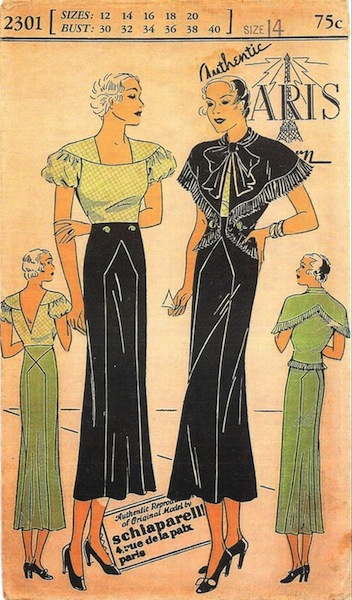
Have you heard? The house of Schiaparelli, founded by the legendary Elsa Schiaparelli (1890-1973) and dormant since 1954, has been revived.

Last year Christian Lacroix presented a one-off couture collection for the house, and this week the new head designer, Marco Zanini, presented his first Schiaparelli collection at the Paris couture. (See the Spring 2014 collection on style.com Vogue Runway, or read W’s coverage of Zanini’s appointment here.)


The high-profile revival follows the Costume Institute’s major 2012 exhibition, Schiaparelli and Prada: Impossible Conversations (see my earlier post here). And, timed to coincide with couture week, an auction of Schiaparelli’s personal collection takes place Thursday at Christie’s Paris.

Many of you will be aware of Schiaparelli’s licensed sewing patterns, since she was among the first designers of Vogue Paris Originals. There were also Schiaparelli knitting patterns. If you knit, you can download a free pattern for Schiaparelli’s 1927 Bowknot sweater, updated by Lisa Stockebrand (Ravelry page here):

Like Vionnet, Schiaparelli also saw commercial sewing patterns for her designs in the interwar period, released by companies including the McCall Pattern Company, Pictorial Review, and the Paris Pattern Company. Here is a selection of early Schiaparelli patterns.
This McCall pattern is the earliest Schiaparelli pattern I’ve seen. Dating to the autumn of 1929, it’s a pattern for a blouse, skirt, and coat with angled pockets. It was still shown in a 1930 catalogue:

Here is the illustration of McCall 5839 in McCall’s magazine:

This Schiaparelli pattern from the Paris Pattern Company has some unusual details. The wrap skirt buttons diagonally across the hips and has two slits through which the blouse’s attached scarf can pass, for a suspender effect:

McCall 6981 is a three-piece suit consisting of a jacket, cropped pussy-bow blouse, and sleeveless, bias dress:

Here’s an illustration of this design (centre, no. 14) in the summer 1932 issue of McCall Fashion Bi-Monthly. Elsewhere it calls McCall 6981 a “trick” ensemble, since the blouse and jacket disguise a dress suitable for tennis:

This Benito illustration for Vogue shows a similar Schiaparelli ensemble, worn with a tomato red Sicilian cap:

This Pictorial Review Schiaparelli adaptation dates to late 1933. The dress has interesting details like shoulder flanges, diagonal waist darts, and inverted darts radiating from the neckline:

Here’s the catalogue illustration for Pictorial Review 6764:

Paris Pattern 2286, illustrated in my 1934 Paris and Style Patterns booklet, is a jaunty ensemble consisting of a coat, skirt, and jacket blouse. The description reads, “A superb town and country suit. Just the thing for that week end vacation. Top coat can be worn over any dress. The skirt and jacket blouse make an ideal spectator costume”:

Also in this leaflet is the Schiaparelli dress and capelet ensemble available as a reproduction from the Vintage Pattern Lending Library. The dress has shoulder yokes, puffed sleeves, and a skirt with pointed set-in panels and pair of buttons at the waist; the matching capelet is trimmed with pleating and buttons to the skirt front. Thanks to owner Deirdre Duggan for providing a scan of the envelope:

Finally, from McCall’s, this Schiaparelli dinner dress in two lengths dates to winter 1936-37. The bodice back extends into sleeves that are gathered into a heart-shaped bodice:

The pattern is illustrated in the January 1937 issue of McCall’s magazine, which made much of the new, street-length hemline:

Schiaparelli patterns from between the wars tend to lack the surrealist touches we associate with the designer, since many of these were based on couture embellishment, accessories, or notions. (Cricket buttons, anyone?) I remember reading a contemporary 1930s article that said Schiaparelli pieces were so simple, they were too easy to copy. Today one might say it’s her brand of dynamic severity that makes her clothes seem so modern.
Bonus: The Art Deco Society of California has posted instructions for Schiaparelli’s “Mad Cap” (via What Would Nancy Drew Wear?).
Nice write up! I did not know that there were Schiaparelli patterns. Thank you for the information and the write up. Her designs fall into today’s fashion aesthetic in such a big way.
I wrote a blog post about her back in July. When I was writing this post, I discovered a pair of animal print booties for sale identical to Elsa Schiaparelli’s personal pair! Here’s the link. I hope you don’t mind. (I know, I’m shamelessly self promoting). http://seweverythingblog.wordpress.com/2013/07/19/elsa-schiaparelli-shocking-influencer-of-her-time/
Thank you for such a fascinating read…as usual. I learn so much from your blogs. I love her jumper design and would love to knit one!
I would never have guessed those were Schiaparelli; they seem a million miles away from the Lobster and skeleton dresses. Interesting to see another side to her work. Looking forward to the next installment.
So interesting! Schiaparelli has never been my favorite designer, but these patterns are totally fascinating – and I agree, very modern and timeless.
Really interesting, thank you so much! Here http://www.pinterest.com/pin/381328293418916748/ you’ll find another Pictorial Review pattern and there http://www.pinterest.com/pin/381328293420746369/ McCall 7976 by Schiaparelli. And here http://www.pinterest.com/pin/381328293420516109/ a Simplicity scarf dress.
Interesting and informative as always. Thanks
In my journey through thirty years of Delineator magazines, I find patterns that refer to Schiaparelli and other designers, but they usually say “Chanel-influenced” or “Schiaparelli-type,” so I am always skeptical about whether the designers had a business reationship with Butterick, or were being copied without the designers’ participation. The Paris patterns you’ve posted are new to me– and seem to refute the claim that “designer patterns” as we now know them were first made available by Vogue in 1949. (a claim made on the Butterick site.) Thank you! I recently found two Butterick Schiaparelli patterns described in Delineator that do not have the usual “hedge” words. I will post them this week. Great blog!
Thank you! I sense that Butterick was very careful after the Vionnet lawsuit.. But it does seem that licensed patterns are a postwar phenomenon. The couture copying industry that flourished before WW2 can be pretty surprising to us today!
Great article, as always!